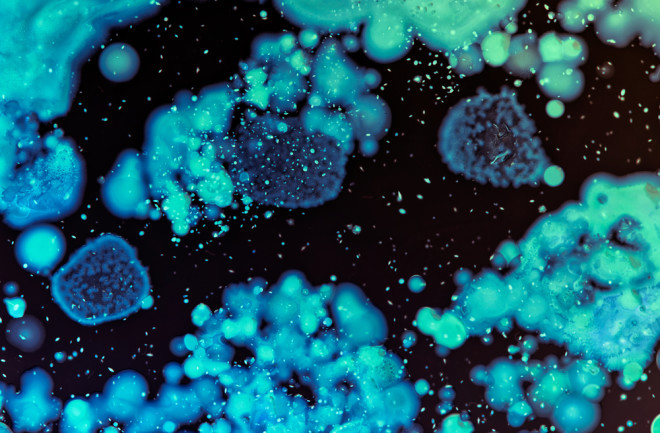There's a whole world of stunning and strange microorganisms that scientists are just starting to discover. But doing so hasn't been a walk in the microbial park. To identify these microbes and to decipher their secrets, scientists have needed to think outside of the box, searching for microbes in some pretty odd and outlandish places.
For Joseph Mougous, a microbiologist at the Howard Hughes Medical Institute and the University of Washington, that means putting people’s mouths to practice.
The Tiny Bacteria in Our Mouths
On our tongues and teeth are billions and billions of microbes, many of which have never been cultivated in labs. Oral swabs reveal the existence of these microorganisms, known as "microbial dark matter," which includes a subset of small bacteria that live off comparatively large bacteria.
Studying Parasitic Mouth Bacteria
Pioneering a new approach for studying these small, parasitic bacteria, Mougous and his colleagues have provided new insights into the tiny lives of microbes. According to the team, these insights could contribute to the development of human health therapies and to the understanding of our mouths' microbiomes.
What Is Patescibacteria?
In 2013, a team of researchers proposed a new name for a strange group of super-small bacteria. The so-termed Patescibacteria attach to the surface of large bacteria and appear to parasitize them, extracting important resources like vitamins. It’s been discovered that these bacteria live inside human mouths, though they're also found almost everywhere that researchers look.
The Decision to Analyze Patescibacteria
Familiar with this work and wanting to learn how these organisms eke out their living, Mougous and his colleagues set out to discover the molecular mechanisms fueling the Patescibacteria lifestyle. But no one had ever cultivated Patescibacteria in the lab.
That’s why they were considered "dark matter," Mougous says, since researchers knew that they were abundant but were unable to characterize their DNA.
"It is a significant proportion of all the bacteria out there," Mougous says of these Patescibacteria, but "we don’t know what their genes encode."
Examining the Genes of Mouth Microbes
In a paper published in September in Cell, Mougous and his colleagues introduced a new strategy for isolating and propagating these microbes in the lab. Their strategy allowed the team to identify and genetically manipulate mouth-dwelling Patescibacteria in such a way that they gained a sense of what the microbes' different genes actually do.
Read More: Half of You Isn’t Human
Illuminating Human Mouth Bacteria Under a Microscope
To start, Mougous and his colleagues introduced green fluorescent proteins to the Patescibacteria so that they would be easier to observe under a microscope. After incorporating the proteins, Mougous and his colleagues watched as the green, gleaming bacteria attacked, attached, and multiplied on host cells.
"They’re sort of analogous to phage in a sense, in the way they attach to bacteria," says Mougous.
Introducing DNA to Patescibacteria
Next, the team introduced new DNA to the Patescibacteria, allowing Mougous and his colleagues to observe how the bacteria's behavior changed and how tinkering with their genes affected their functioning. This revealed which genes are necessary for the Patescibacteria lifecycles.
Though there's still a lot that they don’t know, Mougous says that future researchers can build on his team's baseline, applying the findings to the fields of human health and therapy.
Read More: The Secret Cleaning Power of Bacteria
How Microbial Dark Matter Affects Us
Learning more about microbial dark matter is important for a number of reasons. With other bacteria types, algorithms are pretty good at predicting the function of specific genes. But that's not the case with Patescibacteria, which are so different from other microbes that researchers are at a loss when it comes to their genetic makeup.
Genetic Tools for Therapies
Beyond the purely scientific benefits of building our knowledge of the bacteria, learning more about Patescibacteria genes could contribute to the development of important genetic tools for future human therapies. DNA from Streptococcus thermophilus bacteria helped scientists develop the gene editing tool CRISPR, for instance, and something in the Patescibacteria could be useful for scientists in the future, too.
“Here’s this big untapped treasure chest of DNA that is very divergent from other DNA that we haven’t been able to look at,” Mougous says.
Oral Health Benefits of Mouth Microbes
Understanding these microbes is important for other areas of human health, too. As parasites, Patescibacteria perform an ecological function, regulating the microbiomes in which they live. They may act as population control, for instance, limiting the spread of harmful or benevolent bacteria. And this may have a trickle-down effect on our health and well-being.
Because the Patescibacteria analyzed in the study are found in the human mouth, Mougous says that they may have an impact on our oral health. But additional research is necessary to fully understand the microbes' role in our mouths' microbiomes.
"The major finding is that we’ve made accessible the study of this large group of organisms that are very divergent from characterized bacteria," Mougous says.
Read More: Why Bacteria Are the New Disease Fighters

